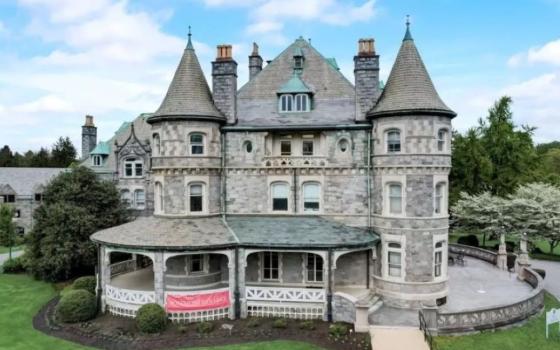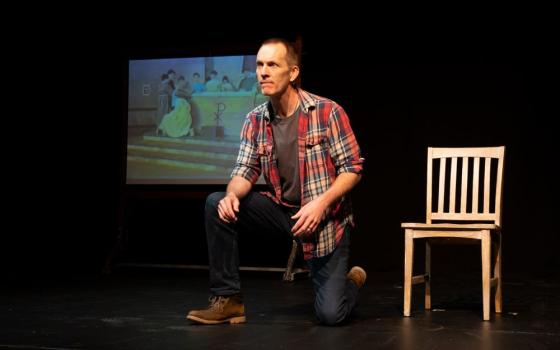
ALBUQUERQUE AND LAS CRUCES, N.M. -- New Mexico has about it an austere, out-of-the-way character, long stretches of desert and horizons of abraded, reddish mountains, evocative of the biblical quality of unseen significance. Few might look to New Mexico when conversation turns to the future of the church.
If so, they could be missing something. This land of hidden prospects might hold some answers for the future.
The church here has a history that arches back 400 years through struggle and eventual resolution among the indigenous culture and Spanish missionaries and colonists. This is not the Irish church; it is not the church of immigrants striving to make it in a WASP culture. It has never had the money or other resources to heap up great monuments of granite and marble. It is a humble church, even today, but one rich in examples of hard-earned successes.
Fittingly, the Catholic Center in the Santa Fe archdiocese is a modest structure on a campus that includes a high school.
In Las Cruces, a diocese that sprawls along the state's southern border, the Diocesan Center has the low-slung look of a typical strip mall installation. It would be difficult to gin up a great deal of hubris in such an environment, especially when one wall of the main corridor of the center is lined with the haunting, iconic wood engravings of Fritz Eichenberg, whose work was popularized by Dorothy Day's Catholic Worker newspaper.
A third diocese, Gallup, describes itself as a mission diocese within the multicultural Southwest. It covers areas of northwestern New Mexico and northeastern Arizona.
In many ways, the church in New Mexico stays close to the ground and to the people. It never has had an abundance of “homegrown" priests. Because of the great distances between places (the drive from the eastern to western extremities of the Las Cruces diocese takes about 10 hours by car) Catholics traditionally have had to fend for themselves in a way that those in parishes of the Northeast, for instance, have not.
No great Catholic institutions have arisen here, so Catholicism has had to inject itself in different ways into institutional life. At the University of New Mexico, for instance, Richard Wood founded the Southwest Institute on Religion and Civil Society, to which he brings a background steeped in Catholic social tradition. It is a tradition that is strongly reflected in the institute's programs and research topics.
 "The things that other places worry about are the way things have always been here, and we've survived," said Dominican Fr. Matthew Strabala, director of the Dominican Ecclesial Institute, a collaborative effort among the Dominicans who run the Aquinas Newman Center at the University of New Mexico, the archdiocese and lay participants. "That's not to put everything in the negative. There's something about the style of church here, it's as old as the hills."
"The things that other places worry about are the way things have always been here, and we've survived," said Dominican Fr. Matthew Strabala, director of the Dominican Ecclesial Institute, a collaborative effort among the Dominicans who run the Aquinas Newman Center at the University of New Mexico, the archdiocese and lay participants. "That's not to put everything in the negative. There's something about the style of church here, it's as old as the hills."
Out of that history has come "a balance, a collaboration, between the different dimensions of it — the Spaniard style and the Pueblo spirituality — and life does just move at a different pace here. It's the older style Spanish Catholicism, where it's much more community-based," he said. "It's not as instinctively hierarchical" as in other parts of the country.
It is easy to get the impression that this is one of those places where theology and necessity are meeting to fashion something new, the shape of which is not yet clear.
Dominican Sr. Bernice Garcia is keeping things together at St. Francis Xavier Parish in a poor neighborhood in downtown Albuquerque. Her title is parish administrator, but by any other name (canonical precision notwithstanding) she's the pastor. Ten years ago, a visitor here would not have encountered a woman holding that position. Garcia never dreamed as a little girl growing up in this parish that she would one day be the equivalent of its pastor. Is she now a sign of the future?
Later in the day of my visit with Garcia, I met with Archbishop Michael J. Sheehan. I asked if 10 years from now a visitor might encounter more Sr. Garcias in that pastoral role. His response: "Maybe deacons."
The underlying presumption, of course, is that in 10 years permanent deacons would still be an all-male group.
If deacons figure to be a significant part of the future, the Santa Fe archdiocese has a good jump on it. Sheehan points out with some pride that permanent deacons now outnumber priests, a group that includes a substantial percentage of foreign priests. The breakdown is telling:
- Of 86 active diocesan priests, 14 are foreign.
- Of 91 religious order priests, 17 are foreign.
- Of 220 ordained permanent deacons, 187 are active, 10 more than the number of priests.
A reality today, said Deacon Steve Rangel, director of deacons and of pastoral outreach for the archdiocese, is that while the faith remains constant, the church keeps changing. "The church here adapts and makes whatever modifications and changes are necessary because the centermost part of it is our faith. It is like a leaf going down a stream. There may be boulders and other obstructions, but the leaf will find the path, it follows the flow, it doesn't fight against it."
 Several hours to the south, in Las Cruces, some of the adaptations are apparent. The chancellor is Wayne Pribble, who previously owned and operated a psychological and psychiatric clinic in Indianapolis. The vice chancellor is Debbie Moore, who began working for the diocese in 1984, starting as a secretary in the ministries office.
Several hours to the south, in Las Cruces, some of the adaptations are apparent. The chancellor is Wayne Pribble, who previously owned and operated a psychological and psychiatric clinic in Indianapolis. The vice chancellor is Debbie Moore, who began working for the diocese in 1984, starting as a secretary in the ministries office.
They comprise two members of a chancery staff that is all laypeople and religious sisters. In an interview Bishop Ricardo Ramirez points out that there is no full-time priest at the pastoral center. "The vicar general is not here full-time. Our chancellor is a layman; our vice chancellor is a laywoman. I'm the only one that's full-time, and even I am part-time because I'm out a lot."
Las Cruces is a very poor diocese in a state that in 2007 was ranked 44th in household income. As much as 20 percent of the diocese's funding comes from outside, primarily from the U.S. bishops and the Extension Society. This close to Mexico, immigration issues color everything. Catechists have to be aware in their planning not to ask youngsters to travel to gatherings that will require going through highway immigration checkpoints. Being a member of the church here is a no-questions-asked proposition. Illegals are welcomed. Ramirez says he is proud of the U.S. church as a whole in its efforts to "welcome the stranger."
In conversations, people often acknowledge, without prodding, the pervasive poverty if only so they can talk about how rich they are in other things, those intangibles that arise out of their history and experience.
"Historically, the sense of the church has been borne here by the community," said Strabala. "It's who they are ... Catholicism is really part of the air that's breathed out here."
 ------------------------------------------------------------------------------
------------------------------------------------------------------------------
Tom Roberts, NCR editor at large, is traveling the country reporting on parish life. His e-mail address is troberts@ncronline.org. Read the full series here: In Search of the Emerging Church.
--------------------------------------------------------------------------------
Follow Tom Roberts on his journey "In Search of the Emerging Church." Sign up to receive an e-mail alert when his stories are posted to this series. If you already receive e-mail alerts from NCR, click on the button that says "update my profile."
--------------------------------------------------------------------------------




